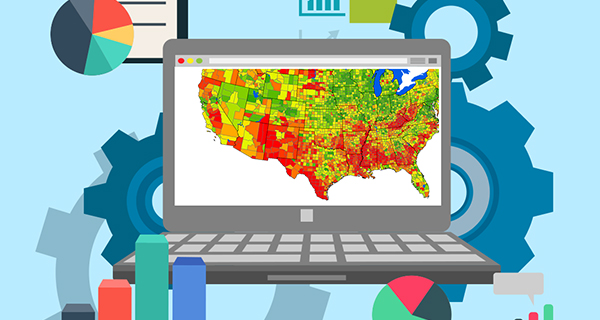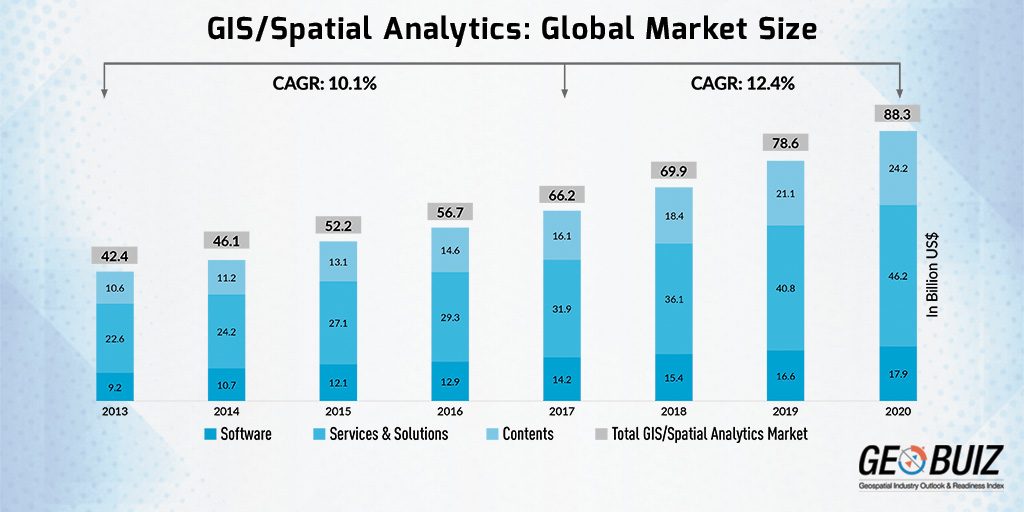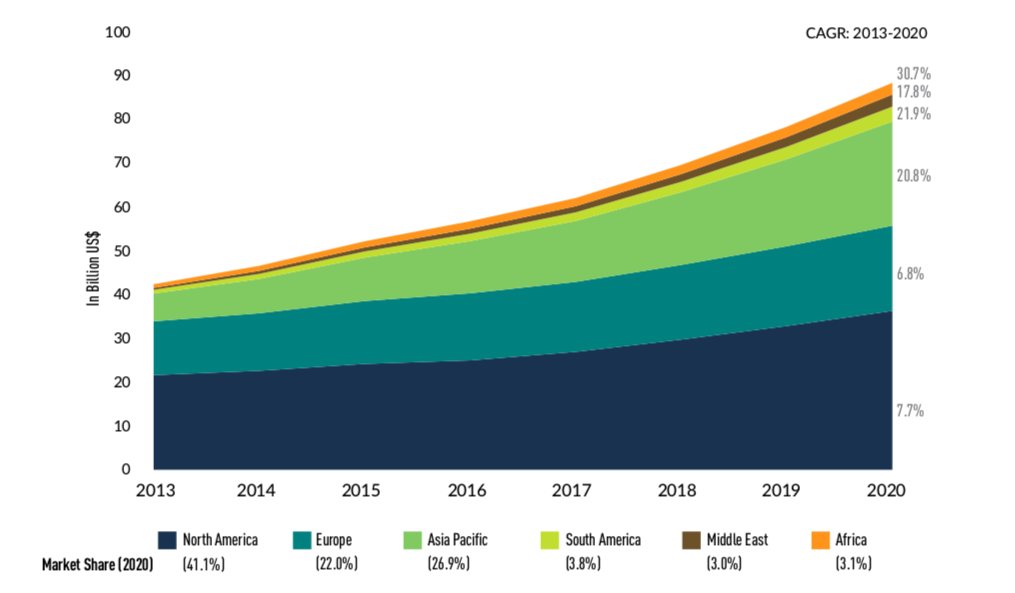The global GIS and Spatial Analytics market to touch US$88.3 Billion by 2020

GIS and Spatial Analytics Market: Global Size

The GeoBuiz-18 report estimates the GIS and Spatial Analytics market to be the second largest after the GNSS and Positioning market. The GIS and Spatial Analytics market is expected to grow from US$ 66.2 Billion in 2017 to US$ 88.3 Billion in 2020 growing at a CAGR of 12.4%. In the recent period, because of the transition from 2D-based maps to 3D-based maps, the demand of 3D GIS is on the rise. As more developing countries like China and India, focus on the development of Smart Cities, the adoption of GIS for 3D urban mapping becomes imperative thus contributing to the increasing market of GIS/Spatial Analytics technologies. This has resulted in the creation of new breakthroughs in spatial modeling and location analytics. Furthermore, the services and solutions segment of the GIS and spatial analytics market is expected to grow much faster than the software business. While the software GIS market is expected to be US$ 17.9 Billion in 2020, the Services and Solutions, and the Content segment is going to hold the largest share of the pie with US$ 46.2 Billion and US$ 24.2 Billion in 2020 respectively.
GIS and Spatial Analytics Market: Regional Share
The GeoBuiz-18 report highlights that the North America region shall continue to be the major shareholder of the GIS and Spatial Analytics market in the near future. Estimated to grow at 7.7% CAGR between 2013-2020; the North America region is expected to have a share of 41.1% of the total GIS and Spatial Analytics market in 2020. While this share is on the conservative side highlighting a fall from 43.3% of the total market in 2017 – the North America region shall continue to be the market leader. This growth momentum can be attributed to the focused investments of the Federal government of USA to deploy GIS software and services for its employees and other associated government bodies. Additionally, the European region shall continue to grow at a marginal rate of 6.8% CAGR between 2013-2020 and is expected to have a share of 22% of the total GIS and Spatial Analytics market in 2020.
GIS/Spatial Analytics Market: Region-wise Growth

Similar to the trends observed in the GNSS and Positioning market analysis, the Asia-Pacific region is expected to grow at a much faster pace than all other regions, capturing approximately 26.9% of the total GIS and Spatial Analytics market in 2020. Increasing investments by the governments in varied application areas and program mandates are going to be the key drivers for increased GIS adoption in this region. Estimated to grow at 20.8% CAGR between 2013-2020, the GIS market in this region is going to be driven by the collective efforts of government, the private sector, entrepreneurs, planners and decisionmakers, and academia and institutions. A case in point is the Indian government. The Government of India, through its Digital India Initiative and other key schemes and programs (for instance: AMRUT, Smart Cities, IPDS, and DILRMP) has mandated the development of a GIS-based database in the country. Also, the government is focused on identifying the untapped potential of GIS implementation through the ‘National GIS Vision’ as charted under the 12th five-year plan (2012-17). In this regard, the Indian Geospatial Economy (IGE) -2018 report, highlights that the GIS and Spatial Analytics market is the second biggest contributor to the geospatial market in India, constituting 23.1% of the total market with an estimated market revenue of INR 1,771 crore in FY 2017-18. This figure is estimated to reach INR 2,674 crore in FY 2020-21.
Similar growth stories are taking place in other Asian economies like China, South Korea, Japan, etc., where focused schemes and initiatives are going to drive the GIS and Spatial Analytics market growth.
GIS and Spatial Analytics Market: Technology Drivers

According to the GeoBuiz-18 report, Cloud Computing, Big Data Analytics, and the Internet of Things (IoT) are the key drivers of the GIS and Spatial Analytics market. Today, most of the GIS services such as maps database, imagery, and base maps are all available in the cloud. The technology and architecture associated with the cloud technology enables computing and analytics on the geographic information systems with ease. Also, this enables users to use geospatial data with ease without having to worry about data storage, data security, and other privacy concerns. Similarly, Big Data Analytics is a crucial driver of GIS and Spatial Analytics segment. GIS and Spatial Analytics segment forms the core of the industry value chain, receiving large amounts of spatial and non-spatial data from all sources so as to derive actionable insights; Big Data Analytics has expanded the scope of applicability for GIS-based solutions to create integrated and actionable contexts. “Cloud computing, combined with IoT, devices, and apps, is beginning to enable an instrumented world — a digital twin in which computing can be harnessed to respond to new kinds of trends. New companies who understand these concepts, share a vision for them, and will envision and implement new kinds of geospatial solutions will ultimately emerge” highlights Dangermond.
GIS and Spatial Analytics: Recent Technology and Business Innovations
Although the inception of the GIS and Spatial Analytics industry began decades ago, this segment continues to be dominated by technology and business innovations on a regular basis. The debate has moved away from whether the ‘S’ in GIS is a system, sciences, studies, or service, but of breakthroughs in terms of services, and product development. Web and Cloud GIS-based applications are enabling users to easily access and process large chunks of geospatial data; integration of GIS, 3D modeling, and virtual reality holds immense promise for domains like infrastructure and urban planning; Mobile GIS has made the technology more user-friendly; real-time streaming of data is now a reality; and the transition from the traditional 2D maps to 3D maps are some of the key technology innovations of this segment.
GIS and Spatial Analytics Market: The Future
In the recently held, Geospatial Artha Summit at the India Habitat Centre, R.S. Pawar, Chairman and Managing Director, NIIT Group, pointed out, “GIS is the universal glue using which we should bind together things and achieve growth, which has no limits. We should search more and more and innovate.” In perspective, the GIS and Spatial Analytics market is going to witness continuous growth primarily driven by the demand in developing economies. As these economies strategize and digitize their citizen services in entirety, GIS is going to be crucial to maintain transparent and efficient service delivery. Furthermore, the increasing demand to build sustainable and efficient infrastructure due to rapid urbanization and population growth (esp. in developing economies), the AEC industry is going to be heavily reliant on GIS and BIM compliant processes. In this regard, the integration of BIM and GIS is seen to be the mainstream method of working. Nicolas Mangon, Vice President, AEC Business Strategy and Marketing, Autodesk, sums it up accurately, “Within the AEC industry, the integration of BIM and GIS data shall provide the much-needed impetus to Governments, citizens, and businesses.” In the next few years, GIS and location-based GIS data shall only empower its users with capabilities to respond to market trends and demands. The potential of the segment is huge, its only up to the stakeholders to capitalize on it and enrich and augment the evolution and transformation of GIS.
To sum up, the GIS and Spatial Analytics market segment is open to multiple opportunities. To understand in detail the global market size, regional market size, technology drivers, benefits and challenges, and recent business innovation and trends of the four crucial technology segments of the geospatial ecosystem, download your FREE copy of GeoBuiz-18 report, today!
Source: https://www.geospatialworld.net/blogs/gis-and-spatial-analytics-market/












